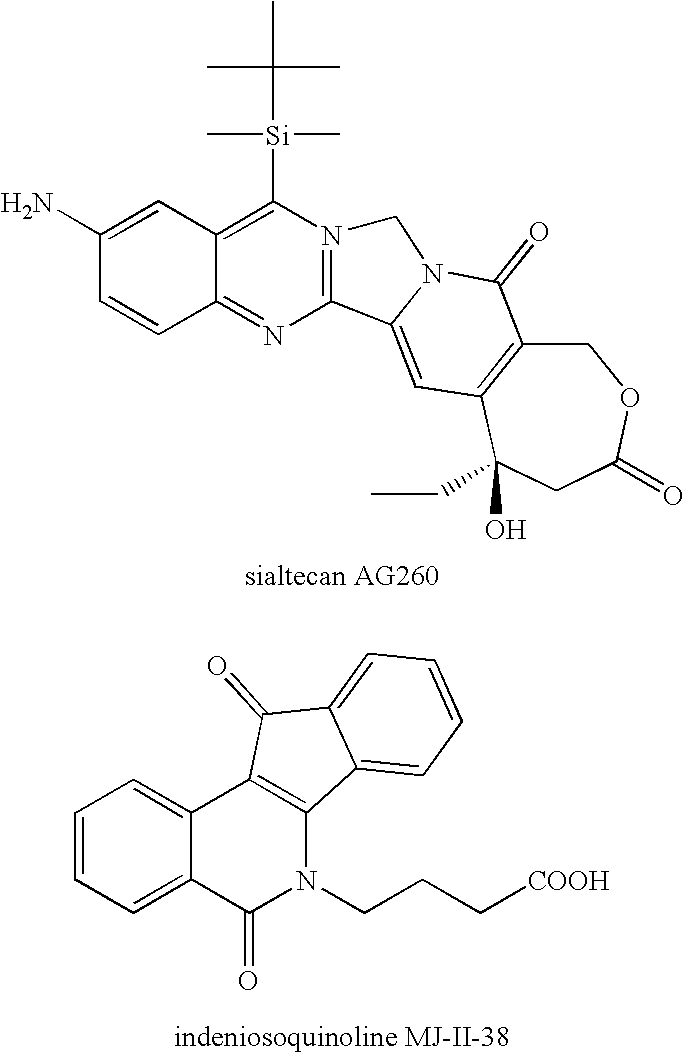Screening methods for identifying ligands
a screening method and ligand technology, applied in chemical methods analysis, separation processes, instruments, etc., can solve the problems of difficult or expensive acquisition or maintenance, laborious or expensive assays, and large screening approaches that are difficult or expensive to achiev
- Summary
- Abstract
- Description
- Claims
- Application Information
AI Technical Summary
Benefits of technology
Problems solved by technology
Method used
Image
Examples
example 1
Preparation of Topoisomerase I Construct
[0072]The 70 kDa human topoisomerase I construct of residues Lys175 to Phe765 (topo70, missing the non-essential unconserved NH2-terminal domain) was purified from a baculovirus-insect cell (SF9) expression system [Stewart et al., J. Biol. Chem, 1996, 271, 7593]. Final preparations of topo70 were concentrated to 3 or 4 mg / ml in 10 mM Tris-HCl pH 7.5, 1 mM EDTA, and 1 mM DTT.
example 2
Trapping of Topo-I DNA Complex
[0073]Crystallographic studies required that the transient covalent topo I-DNA complex be trapped with the aid of a “suicide substrate” which is composed of a high affinity DNA binding site that contains a 5′-bridging phosphorothiolate at the point of topo I cleavage. Breakage at a 5′-bridging phosphorothiolate results in permanent trapping of the covalent complex since the resulting 5′-terminal sulfhydryl group on the broken strand is not a sufficient nucleophile to promote religation [Burgin et al.].
[0074]Blunt ended duplex oligonucleotides were prepared with a 5′-bridging phosphorothiolate linkage at the preferred site of topo I cleavage on the cleaved strand of the duplex [Burgin et al., Redinbo et al.]. The cleaved strand was prepared by first synthesizing protected 5′trityl-S-2′,5′-dideoxyribonucleoside-3′-O-phosphoramidite building blocks that were then used in standard phosphoramidite oligonucleotide synthesis procedures to produce oligonucleoti...
example 3
Crystallization Trials
[0075]Initial crystallization trials with topo70 and the suicide duplex DNA substrate were conducted in sitting drop format using a Cryschem sitting drop crystallization tray [Carter et al.] (marketed by Charles Supper, Inc). The crystallization screening solutions used were the first 48 solutions from the Crystal Screen Kit [see Hampton Research Solutions for Crystal Growth] (marketed by Hampton Research, Inc.), the 48 solutions from the Wizard I Crystal Growth Matrix [Hol et al.] (marketed by Emerald BioStructures, Inc., see also Table I), and the 48 solutions from the Wizard II Crystal Growth Matrix [Hol et al.] (marketed by Emerald BioStructures, Inc., see also Table 2). The crystallization experiments were set up by first placing 500 microliters of each of the crystallization screening formulations into the reservoir chambers of Cryschem crystallization trays. Each tray has 24 reservoir chambers. Therefore, 6 trays were required to screen all 144 crystalli...
PUM
| Property | Measurement | Unit |
|---|---|---|
| temperature | aaaaa | aaaaa |
| temperature | aaaaa | aaaaa |
| temperature | aaaaa | aaaaa |
Abstract
Description
Claims
Application Information
 Login to View More
Login to View More - R&D
- Intellectual Property
- Life Sciences
- Materials
- Tech Scout
- Unparalleled Data Quality
- Higher Quality Content
- 60% Fewer Hallucinations
Browse by: Latest US Patents, China's latest patents, Technical Efficacy Thesaurus, Application Domain, Technology Topic, Popular Technical Reports.
© 2025 PatSnap. All rights reserved.Legal|Privacy policy|Modern Slavery Act Transparency Statement|Sitemap|About US| Contact US: help@patsnap.com

